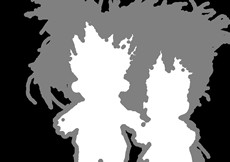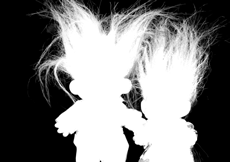This project is built by reproducing the global matting algorithm in the CVPR 2011 paper:
He, Kaiming, et al. "A global sampling method for alpha matting." In CVPR’11, pages 2049–2056, 2011.
## 具体实现
输入:
1、原图src
2、掩码图mask(0为背景,128未知区域,255为前景)
1、expansionOfKnownRegions
根据前后景图像与周围未知区域的颜色、强度相关性,对图像掩码mask做一定程度的前后景扩散,然后腐蚀。
2、找到前景掩码和未知区域边界位置,存入:foregroundBoundary
找到背景掩码和未知区域边界位置,存入:backgroundBoundary
3、随机生成:foregroundBoundary.size + backgroundBoundary.size个坐标点,如果该坐标位置掩码为前景或者背景,
则将该点坐标对应放入foregroundBoundary或者backgroundBoundary。
4、根据foregroundBoundary和backgroundBoundary中存放坐标点对应src图像信息强度,从小到大,对坐标点进行排序。
5、遍历全图未知区域,分别计算每个未知区域点和foregroundBoundary、backgroundBoundary的最小坐标距离平方差。
并随机生成(rand() % foregroundBoundary.size(), rand() % backgroundBoundary.size()).全部存入到samples中。
6、建立数组二维coords,存入src图像坐标从(0,0)到(h,w)存入。
7、循环10次:
7.1、将coords存的坐标数据随机打乱从排。
7.2、循环coords.size()次,每次取出mask[coords[i].x, coords[i].y]数据,如果mask不是未知区域(128),直接进入下一次循环。
7.3、未知区域则取出src该点像素与samples该点参数(s1)。
7.4、以(coords[i].x, coords[i].y)为中心的3x3矩形遍历。
(1)如果矩形中对应位置mask为128,取出该点samples值(s2)。
(2)获取到对应前景背景像素值:src(foregroundBoundary[s2.fi]);src(backgroundBoundary[s2.bj]);
(3)根据当前原地坐标,及取到的前后背景点坐标,论文公式求出alpha,并根据该alpha,求出cost值。
(4)如果s1中没有存储cost或者cost大于当前cost,则更新当前s1中的fi,bj,cost和alpha值。
7.5、循环src.h*src.w组,每组循环k次。
(1)随机生成fi,bj。得到F src(foregroundBoundary[fi]), B src(backgroundBoundary[bj])。
(2)根据每组当前点像素I,以及每次获取到的F,B,计算出alpha,并根据该alpha,求出cost值。
(3)如果s1中没有存储cost或者cost大于当前cost,则更新当前s1中的fi,bj,cost和alpha值。
8、遍历整个掩码图像,如果mask为未知区域(128),则更新该点像素值为:255 * samples[y][x].alpha。
进而得到最终的抠图alpha掩码。
After evaluating the results on the alpha matting evaluation website, this implementation (with matting Laplacian as post-processing) ranks 5th in SAD and 6th in MSE (the original implementation ranks 10th in SAD and 9th in MSE). Running time is less than 1 seconds for an 800x600 image. Hence, this implementation is one of the highest ranked among the fast matting methods.
#include "globalmatting.h"
// you can get the guided filter implementation
// from https://github.com/atilimcetin/guided-filter
#include "guidedfilter.h"
int main()
{
cv::Mat image = cv::imread("GT04-image.png", CV_LOAD_IMAGE_COLOR);
cv::Mat trimap = cv::imread("GT04-trimap.png", CV_LOAD_IMAGE_GRAYSCALE);
// (optional) exploit the affinity of neighboring pixels to reduce the
// size of the unknown region. please refer to the paper
// 'Shared Sampling for Real-Time Alpha Matting'.
expansionOfKnownRegions(image, trimap, 9);
cv::Mat foreground, alpha;
globalMatting(image, trimap, foreground, alpha);
// filter the result with fast guided filter
alpha = guidedFilter(image, alpha, 10, 1e-5);
for (int x = 0; x < trimap.cols; ++x)
for (int y = 0; y < trimap.rows; ++y)
{
if (trimap.at<uchar>(y, x) == 0)
alpha.at<uchar>(y, x) = 0;
else if (trimap.at<uchar>(y, x) == 255)
alpha.at<uchar>(y, x) = 255;
}
cv::imwrite("GT04-alpha.png", alpha);
return 0;
}MIT License.


